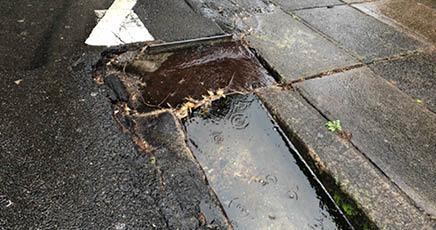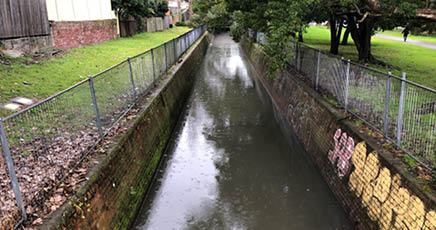LEARNING ACTIVITY
STORY
One Sunday morning, Mick decided that he would bring his treasure box full of unlikely items that he had removed from our waterways over the years. It would be good for Amir and his friends, and the rest of the volunteer group to see the items that end up in stormwater drains that eventually flow into our oceans.
Amir could not believe what Mick was showing them – there were rubber thongs, reusable shopping bags, items of clothing including socks and a t-shirt, lots and lots of chip wrappers and plastic bottles. No doubt every single person who dropped an item into the drain would have thought that their rubbish would not have an impact on the environment.

Stormwater originated as rain and flows into creeks, rivers and other water bodies. Any rubbish or chemical pollution collected during this journey can end up polluting the waterways. This activity looks the impacts of stormwater and rubbish in our waterways.
This learning activity is the fourth part of a sequence of 5 individual learning activities focused on catchment management. The order of these learning activities are: the story of a river, water sustainability, what’s in a drop?, the drain is just for rain and where the river meets the sea.
For children to:
- understand the journey of water into the drains
- learn how different pollutants can enter the waterways
- discover the impacts of stormwater and rubbish in our waterways
- appreciate that what happens on land can impact our rivers and oceans.
This activity can be undertaken at any time of year.
Introduction
This activity investigates the journey of water into the drains. Most rubbish, especially plastics, enters our waterways through stormwater. Explore your school or local area find out what is going down the drain.
*Time allocation includes adult preparation of 10 minutes for the activity.
Checklist
Instructions
STEP 1:
What happens when it rains?
As a class, discuss where the water goes when it rains. You can refer back to the story of a river learning activity to help prompt the discussion.
STEP 2:
Discover stormwater features
Watch the Stormwater network video and identify stormwater features in your local area. These could include creeks, lakes, swamps and wetlands, stormwater channels and drains, as well as pollutant traps.
Are these natural features or urban constructions?
STEP 3:
Stormwater assessment
Students will identify and map the school’s stormwater drains, and identify potential pollution problems.
Divide the school grounds into zones and allocate a group of students to each zone. Each group needs a copy of the school map and the activity sheet.
Groups walk around their zone and mark on the map the location of any stormwater drains. They collect data on the condition of the drain, presence of rubbish and debris, and direction water would flow.
Where possible, follow the drain to see where it ends up i.e., stormwater channel, closed pipe, creek, wetland. Record your data in the activity sheet.
STEP 4:
Discussion and results
As a class, discuss the results of your stormwater assessments.
Did you see impacts of litter, sediment and leaves entering the stormwater drains?
What impacts would this have on the broader community and environment?
Create a list in the activity sheet of what could be done at your school to improve stormwater and runoff.
Extension Activity
Use the map and urban water cycle checklist you created in the water sustainability activity to determine where the stormwater from your school ends up.
Now that you have done a stormwater assessment, look to creating an onsite Junior Landcare group to begin to monitor areas of concern regularly, develop innovative ideas, and clean up to help minimise waste impacts in your local environment.
Curriculum and Framework Links
SCIENCE
Year 7: ACSSU111, ACSSU112, ACSSU116, ACSHE120, ACSHE121, ACSIS124, ACSIS125, ACSIS130, ACSIS131, ACSIS132
Year 8: ACSHE135, ACSIS140, ACSIS145, ACSIS146,ACSIS234
Year 9: ACSSU175, ACSSU176, ACSIS164, ACSIS165, ACSIS170, ACSIS172, ACSIS174
Year 10: ACSSU189, ACSHE191, ACSHE194, ACSIS199, ACSIS204, ACSIS206, ACSIS208
Biology
Unit 1: Biodiversity and the interconnectedness of life
Earth and Environmental Science
Unit 1: Introduction to Earth systems
Unit 3: Living on Earth – extracting, using and managing Earth resources
Unit 4: The changing Earth – the cause and impact of Earth hazards
HUMANITIES AND SOCIAL SCIENCES
Year 7: ACHASSI152, ACHASSI155, ACHASSI154, ACHASSI155, ACHASSI156, ACHASSI158, ACHASSI159, ACHASSI160, ACHASSI161, ACHASSI162, ACHASSK183, ACHASSK185, ACHASSK187
GEOGRAPHY
Year 7: ACHGK037, ACHGK038, ACHGK040, ACHGK042, ACHGS047, ACHGS048, ACHGS049, ACHGS050, ACHGS051, ACHGS052, ACHGS054
Year 8: ACHGK048, ACHGK050, ACHGK051, ACHGK053, ACHGS055, ACHGS056, ACHGS060, ACHGS062
Year 9: ACHGK065, ACHGS068, ACHGS070
Year 10: ACHGK070, ACHGK073, ACHGK074, ACHGK075, ACHGS079
Unit 1: Natural and ecological hazards
Unit 2: Sustainable places
Unit 3: Land cover transformations
HEALTH AND PHYSICAL EDUCATION
Years 7 & 8: ACPPS073
ETHICAL UNDERSTANDING
Exploring values, rights and responsibilities
PERSONAL AND SOCIAL CAPABILITY
Social awareness
CURRICULUM CONNECTIONS
Outdoor Learning
CROSS CURRICULUM PRIORITY
Sustainability
Reference List
ONLINE RESOURCES
Read the Stormwater resources on the Australian Government Your Home website.
Sydney Water has information on Stormwater and water sensitive urban design. You can also look for resources on Stormwater from your local or state water authority and local council.
PRINTABLE RESOURCES
Use these resources from Sydney Water on conducting a Stormwater assessment.
WATCH
Watch this video from Sydney Water the Stormwater network across Sydney (6 minutes)
We value your feedback
When you have finished this learning activity, please tell us what you think with our survey.
Your feedback will help Landcare Australia improve the activities in the Junior Landcare Learning Centre.
Why not try one of our other Junior Landcare learning activities?
Love Letters to the Land
Biodiversity|First Nations Perspectives|Food Production|Waste Management
Creating a worm farm
Waste Management
Caring for our coasts: beach clean-up
Waste Management
Waterways: clean-up
Waste Management



